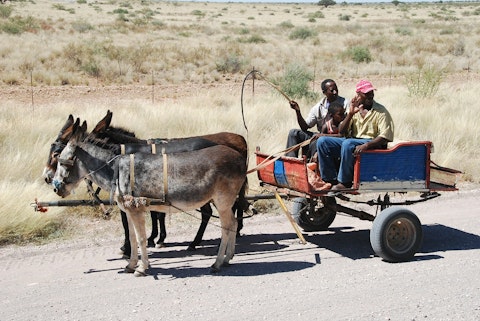Which countries have the most income and wealth inequality? In this article, we have listed the 30 Countries with Highest Gini Coefficient, which expresses the income and wealth inequality.
Inequality among the Top 10% and Bottom 50% Population
According to the World Inequality Report 2022, the global inequalities in income among the richest 10% and bottom 50% population have increased over the last two decades, while global inequalities between countries have declined. The gap between the average incomes of the richest 10% of countries and the poorest 50% of countries plunged over 50x to a little less than 40x. On the contrary, inequalities between the top 10% and the bottom 50% population soared significantly within countries. The gap between the average incomes of the top 10% and the bottom 50% of the population within countries has nearly doubled from 8.5x to 15x over the past two decades.
In 2021, an average adult individual was earning around $23,380 per year and owned around $102,600. The top 10% of individuals in the world currently receive 52% of the global income against a mere 8.5% earned by the bottom 50% of the individuals. Out of the total global income distributed, the average income earned by the top 10% of individuals was around $122,100 per year in 2021. Whereas, the bottom 50% of individuals were earning just around $3,920 per year in 2021.
Inflation has skyrocketed over the past two years. As per the IMF forecast, the global inflation rate in 2021 averaged around 4.7%, 8.8% in 2022, and 6.5% in 2023. In 2024, the average inflation rate is expected to be around 4.1%. Although the inflation rate is declining compared to the past couple of years, consumer index prices are still high. Moreover, the interest rates around the world are at record highs. The IMF has projected the global economy to improve at a rate of 3.2% in 2024 and 3.3% in 2025.
With the global economic distress, global inequalities in income and wealth have massively affected the poorest countries in the world. Inequality varies vastly between the most equal region and the most unequal. In Europe, a more stable region with high-income countries, the top 10% income share is around 36%, compared to the most unequal region, MENA, where the top 10% income share reaches 58%.
The global wealth inequalities are more prominent compared to income inequalities. The bottom 50% of the individuals hardly have any sort of wealth, possessing just 2% of the total global wealth. In comparison, the richest 10% of people own 76% of all global wealth. To understand these figures, the poorest half of the population owns around $4,100 per adult compared to $771,300 owned by the average top 10%.
A Top Company Working on Poverty Reduction
Nestlé (OTC:NSRGY) is one of the leading multinational corporations that operates as a processing giant entity in the food and beverages industry. The company is helping various initiatives to reduce poverty and improve the livelihoods of people by providing job opportunities. Nestlé (OTC:NSRGY), a Swiss-based MNC, is working in collaboration with the UN Sustainable Development Goals (SDGs) to eradicate issues such as inequality, poverty, climate change, and many other global issues.
Around 27 million people are subject to forced labor around the world, mainly in unregulated industries dependent on large-scale employees, such as agriculture. Nestlé (OTC:NSRGY) is working on the potential risks of forced labor in multiple agricultural supply chains through new programs focused on forced labor indicators such as unethical recruitment practices. The company is training relevant employees and staff on forced labor risks. In 2020, Nestlé partnered with Verité to introduce a new framework for labor rights in palm oil which is planned to run through to 2025. In addition, the company is also supporting over 10 million young people in giving access to economic opportunities by 2030, through its income accelerator program in cocoa production. Nestlé (OTC:NSRGY) offers compensation of up to €500 annually to the households of the families taking part in the Income Accelerator Programme. The company is assisting vulnerable labor along with improving its production capabilities. Nestlé has been able to increase its cocoa production by 20% from one hectare of land, since the implementation of the Income Accelerator Programme.
The company’s management expects its organic sales to grow by 4% in 2024 after a slightly off first quarter of 2024. Moreover, the management pointed out during the Q1 earnings to improve its underlying ESP (constant currency) to increase between 6% and 10% in 2024. With a diversified product portfolio and global presence, Nestlé (OTC:NSRGY) is exploring new opportunities in developing countries, which account for nearly 40% of its turnover. In the recent earnings of Q2 2024, the company reported results in-line with its projected growth during Q1. Nestlé (OTC:NSRGY) mentioned that its organic sales are almost back to pre-supply constraint levels and they are starting to retake market share. Here are some of the comments from the Q2 2024 earnings call:
“Given how the environment has unfolded, we consider it prudent to amend our guidance for the full year. We now expect organic sales growth of at least 3% and the underlying earnings per share in constant currency to increase at a mid-single-digit rate, in line with consensus. We are keeping our underlying trading operating profit margin guidance unchanged, with a moderate increase expected. We always said that 2024 was the transition back to RIG-led growth, and that is exactly what is happening. We have one of the most attractive portfolios in the global food and beverage industry. It is positioned to perform in any environment. Our RIG-led growth strategy continues to be the right one for these times and it is working.”
Nestlé (OTC:NSRGY) is working on various initiatives to fight against income inequality. However, many countries are facing huge gaps in wealth equality. With that said, let’s take a look at the countries with the highest Gini coefficient.

Our Methodology
To gather the list of countries with the highest Gini coefficient, we used the Gini coefficient data from Credit Suisse’s Global Wealth Databook 2022. The Gini coefficient describes income inequality or wealth distribution. A Gini coefficient of 0 represents perfect equality and a Gini coefficient of 100 means perfect inequality. The countries with highest Gini coefficients are ranked in ascending order of their Gini coefficients.
At Insider Monkey we are obsessed with the stocks that hedge funds pile into. The reason is simple: our research has shown that we can outperform the market by imitating the top stock picks of the best hedge funds. Our quarterly newsletter’s strategy selects 14 small-cap and large-cap stocks every quarter and has returned 275% since May 2014, beating its benchmark by 150 percentage points. (see more details here).
30 Countries with Highest Gini Coefficient
30. Belize
Gini Coefficient: 83.5%
Belize has one of the highest Gini coefficients and has a GDP per capita of around $11,320. Belize increased its minimum per-hour wage to $5 in 2022. Belize ranks 30th among the countries with highest Gini coefficient.
29. Papua New Guinea
Gini Coefficient: 84.3%
Papua New Guinea has a GDP per capita of $3,530, as of 2024. The country has a population of 10.3 million and an unemployment rate of just under 3%. Papua New Guinea has one of the highest Gini coefficients.
28. Malawi
Gini Coefficient: 84.5%
Malawi has an unemployment rate of 5% and has a total population of around 20.9 million. Malawi is one of the poorest countries in the world and has a GDP per capita of $1,710.
27. Central African Republic
Gini Coefficient: 84.5%
The Central African Republic is also among the poorest countries in the world with a GDP per capita of around $1,120. The Central African Republic has an unemployment rate of around 6.3% out of the total population of 5.7 million.
26. Algeria
Gini Coefficient: 84.8%
Algeria has a Gini coefficient of 84.8% and has a GDP per capita of $16,480. Algeria has a quite high unemployment rate which was around 11.8%, as of 2023.
25. United States
Gini Coefficient: 85%
The United States is one of the wealthiest countries in the world. However, the income disparity between the top 10% and the bottom 50% is just like most developed countries. The top 10% in the US captures 45.5% of total income while just 13.3% goes to the bottom 50%.
24. Republic of the Congo
Gini Coefficient: 85.5%
The Republic of the Congo is one of the poorest countries in the world with a GDP per capita of $4,740. The Republic of the Congo ranks among the countries with highest Gini coefficient.
23. The Gambia
Gini Coefficient: 85.7%
Another African country, The Gambia has an unemployment rate of 6.5% and a total population of 2.7 million. The Gambia has a GDP per capita of just under $3,000.
22. Nigeria
Gini Coefficient: 86%
Nigeria has one of the largest populations in the world, with a total of 223.8 million people. In Nigeria, the top 10% earns around an average of €32,700 compared to an average earning of €2,400 by the bottom 50%. Nigeria ranks 22nd among the countries with highest Gini coefficient.
21. Comoros
Gini Coefficient: 86.1%
Comoros has a Gini coefficient of around 86.1% and has a GDP per capita of $3,530. Comoros has an unemployment rate of 5.8% and is one of the countries with highest Gini coefficient.
20. Kuwait
Gini Coefficient: 86.2%
Kuwait is a small island country with a population of 4.3 million. Kuwait has one of the lowest unemployment rates, around 2.1%.
19. Saudi Arabia
Gini Coefficient: 86.4%
Saudi Arabia has a Gini coefficient of around 86.4%. Saudi Arabia has an employment rate of around 63.7% and a GDP per capita of $70,330.
18. Equatorial Guinea
Gini Coefficient: 86.4%
Equatorial Guinea is a country in central Africa with a total population of 1.7 million. Equatorial Guinea has a GDP per capita of $18,380 and ranks 18th among the countries with highest Gini coefficient.
17. Namibia
Gini Coefficient: 86.8%
Out of the total population of 2.6 million in Namibia, 19.4% of people are unemployed. With a high Gini coefficient score of 86.8%, Namibia is one of the countries with highest Gini coefficient.
16. Philippines
Gini Coefficient: 87.3%
The Philippines has one of the highest employment rates, around 95.9%. The Philippines has a total population of 117.3 million and a GDP per capita of around $12,190.
15. Botswana
Gini Coefficient: 87.9%
Botswana is another African country with high poverty. Botswana has an unemployment rate of around 23.4% and ranks 15th among the countries with highest Gini coefficient.
14. Russia
Gini Coefficient: 88%
Russia has a Gini coefficient of 88%. The country’s top 10% earns an average of around €104,600 compared to the bottom 50% earning an average of €7,700.
13. Oman
Gini Coefficient: 88%
Oman has a GDP per capita of $39,860 and a total population of around 4.6 million. Oman has one of the lowest unemployment rates in the world, at around 1.5%.
12. Sweden
Gini Coefficient: 88.1%
The top 10% in Sweden takes around 30% of the total national income, while the bottom 50% takes 24% of the national income. One of the most unequal countries in Europe in terms of income, Sweden has one of the highest Gini coefficients in the world.
11. Yemen
Gini Coefficient: 88.3%
Yemen is one of the poorest countries in the world with a GDP per capita of just $2,000. Yemen has an unemployment rate of around 17.2%.
10. Laos
Gini Coefficient: 88.3%
Laos has a GDP per capita of around $10,240 and a total population of 7.6 million. Laos has a low unemployment rate of 1.2%.
9. United Arab Emirates
Gini Coefficient: 88.5%
The United Arab Emirates is one of the richest Arab countries. The country has around $96,850 and a total population of 9.5 million. The United Arab Emirates has a Gini coefficient of 88.5% and ranks among the countries with highest Gini coefficient.
8. Bahrain
Gini Coefficient: 88.5%
Bahrain is a small island country with a total population of 1.4 million and a GDP per capita of around $62,670. Bahrain has an unemployment rate of 1.2%.
7. Zambia
Gini Coefficient: 88.6%
Zambia is a poor country with a GDP per capita of $4,360 and a total population of 20.5 million. Zambia has a Gini coefficient of 88.6% and ranks seventh among the countries with highest Gini coefficient.
6. Suriname
Gini Coefficient: 88.6%
Suriname’s total population is around 623,240 and almost 7.7% of its population is unemployed. Suriname has a GDP per capita of $18,930.
5. South Africa
Gini Coefficient: 88.6%
South Africa’s bottom 50% earns around €1,300, while the top 10% earns over €82,500, 60 times more than the bottom 50% population. South Africa ranks fifth among the countries with highest Gini coefficient.





